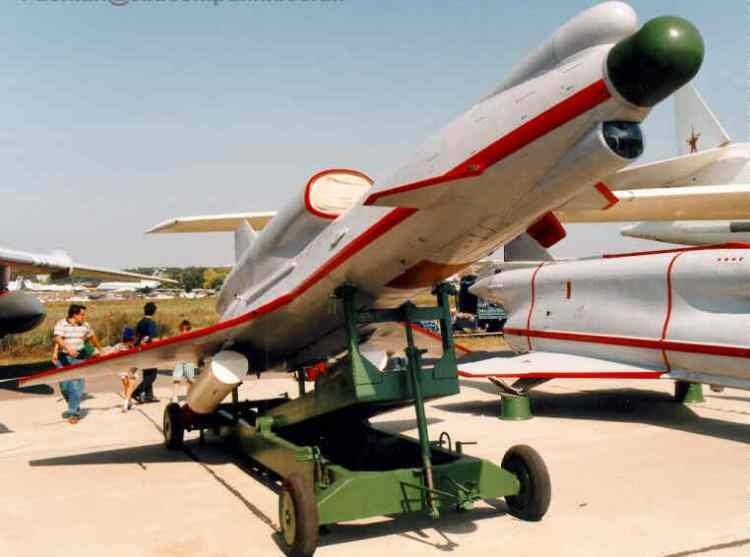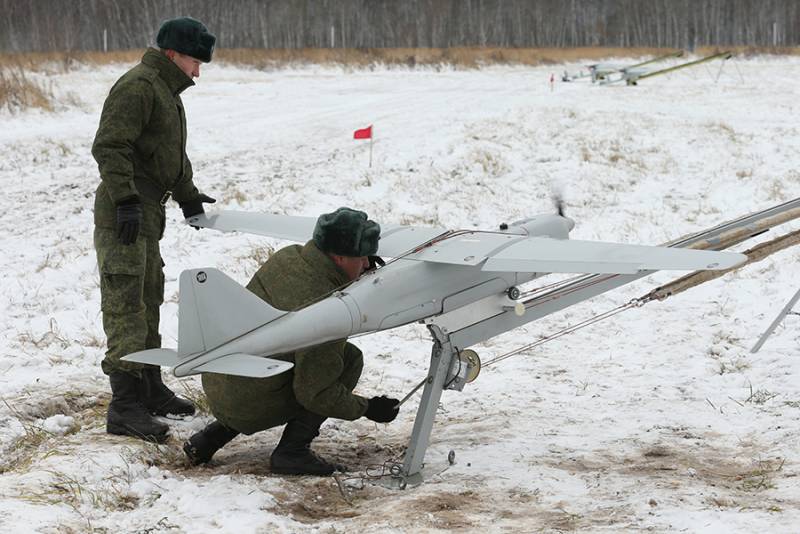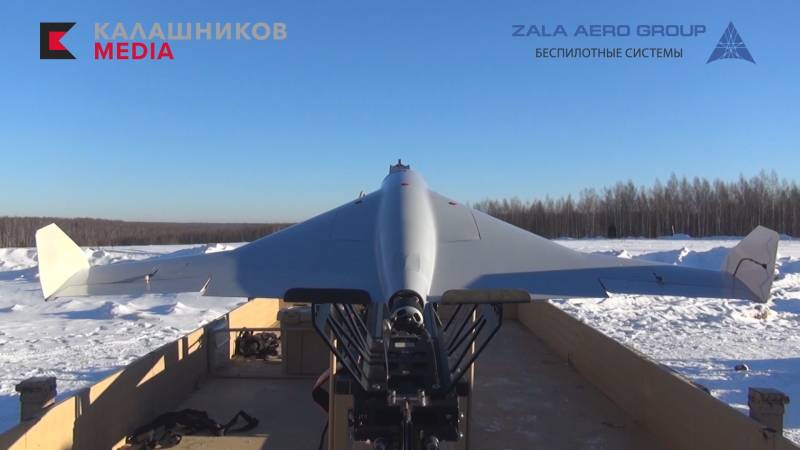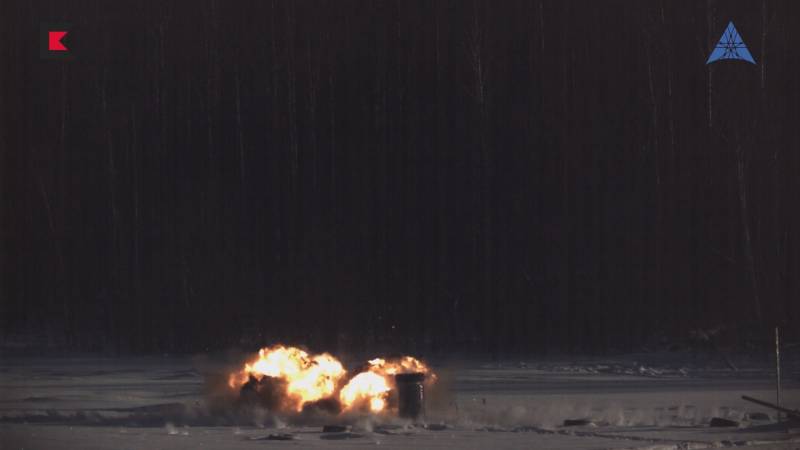Russian drones, kamikaze. Past and future
Past projects
Until recently, the domestic industry was not engaged in the subject of anti-burglary ammunition. Nevertheless, some samples of unmanned vehicles still had the possibility of destroying targets "at the cost of their own lives." So, in the early nineties, a heavy shock UAV Tu-300 "Kite" was launched for testing. It was equipped with advanced optical-electronic equipment and could carry weapons on the external sling.

Heavy UAV Tu-300 "Kite." Photo Arms-expo.ru
The main task of "Kite" was to search for ground targets with their subsequent defeat with the help of suspended weapons - bombs or missiles of various types. According to some reports, the project also envisaged the work of the apparatus as a kamikaze drone. In extreme cases, the UAV could aim at the target and attack it like a rocket. However, it was an extreme measure, and in normal situations the Kite had to return to the base after the flight.
In May, 2016 of the year from unnamed sources in the defense complex became aware of the start of the development of a new anti-warhead ammunition of the “classic” model. This project was probably proposed taking into account foreign experience and provided for the use of proven foreign ideas. It was planned to modify one of the existing domestic UAVs, equipping it with a built-in combat unit.
Soon, the Russian press clarified that the new “kamikaze” will be created on the basis of the serial reconnaissance drone Orlan-10. At the same time, the characteristics of the future sample were not specified, although the available data on the base sample allowed for some assumptions. So, with the 14 kg take-off mass, the Orlan-10 carries a payload of 5 kg. It is able to accelerate to 150 km / h to be in the air 16 h and move away from the starting point by 600 km (to 120 km with operator control). Apparently, the locking ammunition based on the Orlan-10 could have similar characteristics.
However, since then, new reports on the creation of anti-burglar ammunition based on reconnaissance UAVs have not appeared. Unfortunately, the current status of this development remains unknown, and this may hint at the lack of real results. Probably, the project was closed due to technical difficulties or lack of interest from the potential customer. As a result, at the moment “Orlan-10” is used to carry various payloads, but not combat units.
Draft present
A few days ago there was a premiere of the latest Russian UAV from the category of anti-ship ammunition. This kamikaze drone was developed by Zala Aero, part of the Kalashnikov concern and one of the major domestic manufacturers of UAVs. The new project is called "KUB-UAV" (English version of KYB-UAV). This product is designed specifically for striking enemy targets and was originally designed to solve such problems.

Preparations for the launch of the device "Orlan-10". Photo of the Ministry of Defense of the Russian Federation
“KUB-BLAH” received a glider of a characteristic look, built according to the “tailless” scheme with a swept wing and a pair of crests at the tips. There is a pronounced fuselage of circular cross section. In the rear fuselage is placed an electric motor with a pushing propeller. For maneuvering applied mechanization on the rear edge of the wing. The fuselage is placed payload of the required type weighing up to 3 kg.
The wing span of the drone is 1,21 m, the length of the fuselage is 950 mm. The device is capable of speeds up to 130 km / h and stay in the air for up to half an hour. The launch is carried out with the help of a starting catapult. Seating devices are not used due to the characteristic role of the product: instead of returning to the launch area, it should attack the designated target.
According to the organization developer, the KYB-UAV UAV can deliver the payload in the form of a warhead to a specified point using a satellite navigation system. Also provides for the use of so-called. target load guidance - optical-electronic system, providing observation of the underlying terrain and search for targets. The use of optical means reduces the allowable weight of the warhead.
Depending on the method of guidance used, the KUB-BLA can attack both fixed targets with known coordinates and moving objects. Stationary objects of the enemy can be destroyed in all modes of guidance. At the same time, the “TV” mode ensures the attack of moving targets, the coordinates of which are constantly changing.
Zala Aero claims that by now the KUB-BLA product has passed the necessary tests and is ready for operation. A video of one of the test launches was published. The video shows the takeoff of the UAV from the starting guide and the fall on the target. Barracking ammunition went to the target almost vertically and deviated from it literally a couple of meters.
A new type of kamikaze drone was presented to the public and potential customers only a few days ago as part of a foreign military technical exhibition. Information about the possible appearance of orders for such a technique has not yet appeared, but news This kind can come at any time. While there is a reason for optimistic forecasts: “KUB-BLA” has every chance to enter service with both the Russian army and foreign armed forces. The emergence of export contracts to some extent contributes to the demonstration of the product at the exhibition IDEX-2019.
Future projects
To date, several promising projects of locking ammunition have been worked out in Russia, but, apparently, only one of them has reached the testing stage. The first Russian kamikaze drone in the past could become the Kite Tu-300, although in his case such capabilities were in addition to the basic means of solving problems. Then the appearance of the combat version of the Orlan-10 product was expected, and recently a completely new specialized KUB-UAV UAV was shown for the first time.
Great hopes are now placed on the latter, and the development company expects that it will manage to interest the Russian and foreign military, after which real orders will follow. However, the opinion of the Russian Ministry of Defense on such a technique remains unknown, which is why the real prospects of KYB-UAV are not completely clear. The proposed model may find a place in the Russian armed forces, but a different outcome is possible.
In the field of export orders may be reasons for optimism. The concept of barrage ammunition enjoys a certain popularity in the world, and the market for such products has already formed. New Russian development is able to win its share of this market and enter the series in the interests of third countries. Demonstration of a ready-made UAV at an exhibition in the UAE should contribute to obtaining such results.
However, the new Russian UAV will face serious competition. Foreign countries have already developed and put up for sale about two dozen types of kamikaze UAVs with different characteristics and capabilities. To win back your niche and gain a foothold in it in such conditions will not be easy at all.
Despite serious progress in the field of barracking ammunition, such products are still of limited distribution and can not compete with other categories of UAVs. The reasons for this are obvious: the kamikaze drone is actually a “hybrid” of reconnaissance aircraft and guided weapons. However, he not only receives the positive qualities of "ancestors", but also has certain disadvantages. In addition, the duplication of the functions of other products may be considered inappropriate.
Barracking ammunition should work as a reconnaissance UAV and look for its target, and then fall on it like a bomb or a rocket. The need to solve two problems of various kinds can lead to complication and cost of construction in comparison with specialized products. Also, a potential customer may have questions about the need to use a kamikaze drone instead of a bunch of reconnaissance UAVs and any available strike system, especially if the latter has great combat advantages.
It is well known that the Russian Ministry of Defense in recent years has shown great interest in promising UAVs capable of carrying combat load. Developed new shock samples of medium and heavy classes. There is no particular interest in disposable anti-ship ammunition. In particular, this may explain a small number of projects of this kind and the absence of such weapons in the army. It seems that the Russian command does not consider kamikaze drones necessary and gives preference to equipment of other classes capable of solving only one task, but to do so with the maximum quality.
However, light vehicles with the ability to conduct reconnaissance and strikes can be used. They can be considered as a special tool for special forces, capable of ensuring the solution of tasks in isolation from the main forces and fire means of other classes. In addition, we should not forget about the international market of weapons and equipment. The creation of exclusively export samples, as practice shows, is a profitable business and allows defense enterprises to earn good money.
Given the current state of affairs and the prospects for its development, the domestic industry should continue the development of anti-burglary ammunition - both as ordered by specific buyers and as an initiative. If the Russian command nevertheless shows interest in such equipment, the army will be able to receive it in the shortest possible time. Also, such developments can be promoted in the international market. Finally, we should not forget that the development of kamikaze UAVs will contribute to the development of the entire direction of unmanned vehicles.
How events will develop in the future - time will tell. However, it is already clear that Russian enterprises are capable of developing and building antiques ammunition. But the real prospects of these projects depend, first of all, on the desires and plans of customers - domestic and foreign military.
On the materials of the sites:
https://tass.ru/
https://ria.ru/
https://russian.rt.com/
https://rg.ru/
https://tvzvezda.ru/
https://kalashnikov.media/



Information